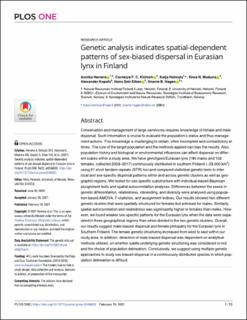| dc.contributor.author | Herrero, Annika | |
| dc.contributor.author | Klutsch, Cornelya | |
| dc.contributor.author | Holmala, Katja | |
| dc.contributor.author | Maduna, Simo | |
| dc.contributor.author | Kopatz, Alexander | |
| dc.contributor.author | Eiken, Hans Geir | |
| dc.contributor.author | Hagen, Snorre | |
| dc.date.accessioned | 2021-10-11T18:34:55Z | |
| dc.date.available | 2021-10-11T18:34:55Z | |
| dc.date.created | 2021-02-23T12:36:58Z | |
| dc.date.issued | 2021-02-19 | |
| dc.identifier.citation | Herrero A, Klütsch CFC, Holmala K, Maduna SN, Kopatz A, Eiken HG, et al. (2021) Genetic analysis indicates spatial-dependent patterns of sex-biased dispersal in Eurasian lynx in Finland. PLoS ONE 16(2): e0246833. | en_US |
| dc.identifier.issn | 1932-6203 | |
| dc.identifier.uri | https://hdl.handle.net/11250/2789100 | |
| dc.description.abstract | Conservation and management of large carnivores requires knowledge of female and male dispersal. Such information is crucial to evaluate the population’s status and thus management actions. This knowledge is challenging to obtain, often incomplete and contradictory at times. The size of the target population and the methods applied can bias the results. Also, population history and biological or environmental influences can affect dispersal on different scales within a study area. We have genotyped Eurasian lynx (180 males and 102 females, collected 2003–2017) continuously distributed in southern Finland (~23,000 km2) using 21 short tandem repeats (STR) loci and compared statistical genetic tests to infer local and sex-specific dispersal patterns within and across genetic clusters as well as geographic regions. We tested for sex-specific substructure with individual-based Bayesian assignment tests and spatial autocorrelation analyses. Differences between the sexes in genetic differentiation, relatedness, inbreeding, and diversity were analysed using population- based AMOVA, F-statistics, and assignment indices. Our results showed two different genetic clusters that were spatially structured for females but admixed for males. Similarly, spatial autocorrelation and relatedness was significantly higher in females than males. However, we found weaker sex-specific patterns for the Eurasian lynx when the data were separated in three geographical regions than when divided in the two genetic clusters. Overall, our results suggest male-biased dispersal and female philopatry for the Eurasian lynx in Southern Finland. The female genetic structuring increased from west to east within our study area. In addition, detection of male-biased dispersal was dependent on analytical methods utilized, on whether subtle underlying genetic structuring was considered or not, and the choice of population delineation. Conclusively, we suggest using multiple genetic approaches to study sex-biased dispersal in a continuously distributed species in which population delineation is difficult. | en_US |
| dc.language.iso | eng | en_US |
| dc.publisher | PLOS | en_US |
| dc.rights | Navngivelse 4.0 Internasjonal | * |
| dc.rights.uri | http://creativecommons.org/licenses/by/4.0/deed.no | * |
| dc.title | Genetic analysis indicates spatial-dependent patterns of sex-biased dispersal in Eurasian lynx in Finland | en_US |
| dc.type | Peer reviewed | en_US |
| dc.type | Journal article | en_US |
| dc.description.version | publishedVersion | en_US |
| dc.rights.holder | © 2021 Herrero et al. | en_US |
| dc.subject.nsi | VDP::Zoologiske og botaniske fag: 480 | en_US |
| dc.subject.nsi | VDP::Zoology and botany: 480 | en_US |
| dc.subject.nsi | VDP::Zoologiske og botaniske fag: 480 | en_US |
| dc.subject.nsi | VDP::Zoology and botany: 480 | en_US |
| dc.source.pagenumber | 22 | en_US |
| dc.source.volume | 16 | en_US |
| dc.source.journal | PLOS ONE | en_US |
| dc.source.issue | 2 | en_US |
| dc.identifier.doi | 10.1371/journal.pone.0246833 | |
| dc.identifier.cristin | 1892717 | |
| dc.source.articlenumber | e0246833 | en_US |
| cristin.ispublished | true | |
| cristin.fulltext | original | |
| cristin.qualitycode | 1 | |

